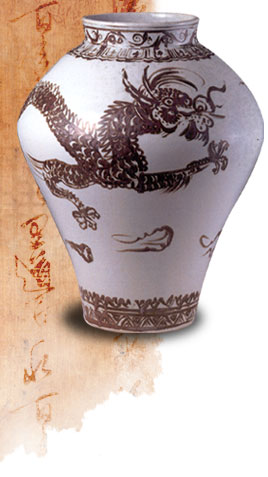 Kim Jeong-ok is the only ‘Human Cultural Property’ that is designated by the Korean government in Kim Jeong-ok is the only ‘Human Cultural Property’ that is designated by the Korean government in
 the art of traditional earthenware making. Thus, he is a leader in the revival of one of Korea’s most
the art of traditional earthenware making. Thus, he is a leader in the revival of one of Korea’s most
 treasured national arts. By successfully reproducing Jeongho Dawan, or Ido Chawan as it
treasured national arts. By successfully reproducing Jeongho Dawan, or Ido Chawan as it
 is called in Japan, he has made a tremendous achievement in revitalizing this profound
is called in Japan, he has made a tremendous achievement in revitalizing this profound
 artistic tradition; this revived tea bowl is widely recognized as a creative triumph that
artistic tradition; this revived tea bowl is widely recognized as a creative triumph that
 can only be achieved by a master potter at the height of his career. It clearly displays
can only be achieved by a master potter at the height of his career. It clearly displays
 his firm determination, immeasurable energy and deep devotion to bring back the
his firm determination, immeasurable energy and deep devotion to bring back the
 golden age of white pottery in his mother country. golden age of white pottery in his mother country.
 Kim Jeong-ok has also been keenly interested in reviving buncheong earthenware, Kim Jeong-ok has also been keenly interested in reviving buncheong earthenware,
 another glorious achievement of the Joseon Dynasty’s potters, which were produced in some
another glorious achievement of the Joseon Dynasty’s potters, which were produced in some
 of Joseon’s most famous kilns such as Gyeryongsan Mountain and Gimhae. His works have
of Joseon’s most famous kilns such as Gyeryongsan Mountain and Gimhae. His works have
 been regularly exhibited in many parts of the world including Japan, Canada, U.S.A. and Germany;
been regularly exhibited in many parts of the world including Japan, Canada, U.S.A. and Germany;
 as well, collections of his pieces are in permanent exhibitions in some of world’s most prestigious
as well, collections of his pieces are in permanent exhibitions in some of world’s most prestigious
 museums, such as the Smithsonian Institution in Washington DC, U.S.A., and the Royal Ontario
museums, such as the Smithsonian Institution in Washington DC, U.S.A., and the Royal Ontario
 Museum in Toronto Canada. His work is also dearly loved by the Dalai Lama.
Museum in Toronto Canada. His work is also dearly loved by the Dalai Lama.
The earthenware made by Kim Jeong-ok lead us to think
not only of their importance as works of art but also the
person who created them. His white pottery,
for example, vividly capture the glory and beauty of the
Joseon white porcelain as well as the souls of the
Joseon potters themselves. As soon as his works are
removed from the kiln, they reveal the graciousness
and elegance of a time gone by. At that moment, when
the fire have died and the kiln has cooled, his
earthenware appears to grow several hundred years older.
They are, in fact, like ‘living’ antiques. They belong to the
past, to a time of creation when traditions were
established by the ancestors; but with love, devotion and
extraordinary talent, Kim Jeong-ok brings these
masterpieces to the present so that they come alive with
their beauty.
 The tradition of Joseon white pottery does The tradition of Joseon white pottery does
 not just denote form or color, or the expert
not just denote form or color, or the expert
 movements of the artist’s fingers. It is
movements of the artist’s fingers. It is
 best represented when art and
best represented when art and
 practicality harmoniously co-exist:
practicality harmoniously co-exist:
 when the natural beauty of form
when the natural beauty of form
 and shape in a work of art is
and shape in a work of art is
 organically interwoven with the practical
organically interwoven with the practical
 usage in the home. The key lies in the
usage in the home. The key lies in the
 austerity and simplicity of the lines and
austerity and simplicity of the lines and
 contours that reflect both the anonymity of
contours that reflect both the anonymity of
 the potter and the common folks who use
the potter and the common folks who use
 the ware. To achieve this, Kim Jeong-ok always
the ware. To achieve this, Kim Jeong-ok always
 tries to remove his identity from his pieces just
tries to remove his identity from his pieces just
 as his ancestors did; he wants to be known not
as his ancestors did; he wants to be known not
 because of an intentionally-malformed shape or
because of an intentionally-malformed shape or
 a singular design, but by his commitment to the a singular design, but by his commitment to the
 life of earthenware making, to following in his family’s
life of earthenware making, to following in his family’s
 footsteps, and to keeping this important national
footsteps, and to keeping this important national
 tradition alive.
tradition alive.
This is why we cannot see the artist’s existence in Kim Jeong-ok’s masterpieces. He only aims to reach the state
that is closest to nature by minimizing the display of his artistic skills and keeping the original purity of the earth.
As a result, his works are like a replica of nature removed from any sign of artificiality; they represent the intimacy
and peace one feels with Mother Nature and Mother Earth. His white pottery is there to be touched, and when it is, it
gives us the warmth and gentleness that the first human being might have felt from the soil under his or her bare
feet. The true significance his earthenware seeks may be a journey back to the earth, the home of his white pottery.
View the master's works |



















